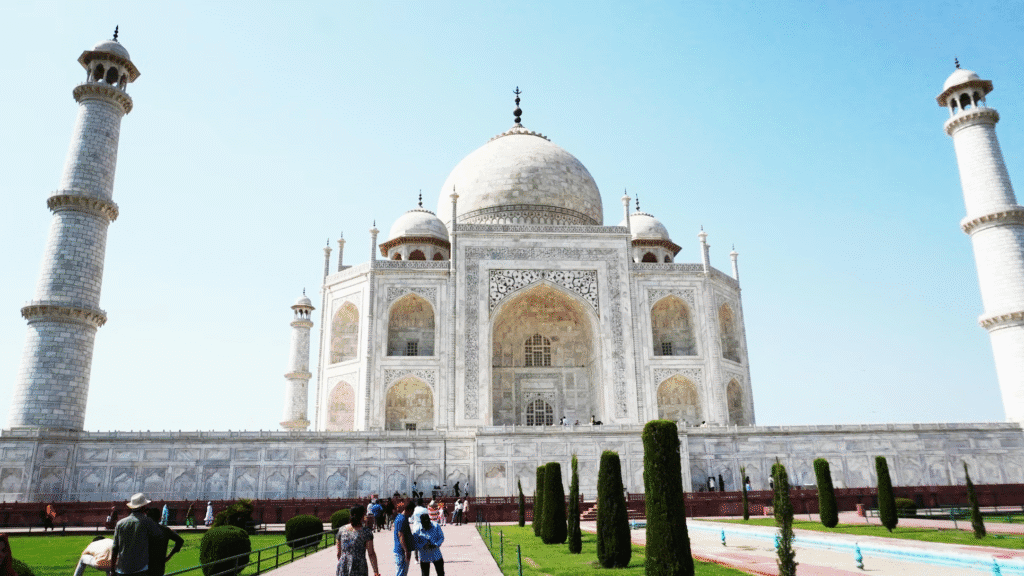Explore the architectural wonders that speak of India’s deep cultural roots and varied past.
From majestic forts to ancient temples, historical monuments of india stand as silent storytellers of a nation shaped by centuries of diverse influences—ranging from empires and invasions to spiritual awakening and artistic brilliance. These monuments are not just stone and mortar; they are symbols of heritage, resilience, and identity that continue to captivate the world.
Each monument reflects the unique imprint of the era in which it was built. Take the Taj Mahal, for example—an eternal symbol of love and Mughal craftsmanship. With its gleaming white marble, intricate inlay work, and symmetrical gardens, the Taj doesn’t just impress with its beauty; it tells a timeless love story that transcends cultures and generations. Located in Agra, this UNESCO World Heritage Site is one of the most visited and photographed structures in the world.
Travel south, and you’ll find the Meenakshi Temple in Madurai, Tamil Nadu—a vibrant blend of Dravidian architecture and mythological storytelling. With thousands of colorful sculptures adorning its towers, this temple is a celebration of religious devotion, artistic excellence, and ancient engineering. Unlike many monuments that lie dormant in history, temples like Meenakshi continue to thrive as living centers of worship and culture.
In the heart of Delhi lies the Qutub Minar, a 73-meter-tall tower built in the early 13th century. It represents the beginning of Islamic rule in India and the evolution of Indo-Islamic architecture. Made of red sandstone and marble, it still stands tall despite weathering centuries of environmental and political changes. Nearby, Humayun’s Tomb offers a glimpse into the architectural style that would later inspire the construction of the Taj Mahal.
Historical Monuments of India That Will Leave You Speechless
India has some of the world’s most beautiful and oldest buildings. These monuments are like giant history books made of stone. They tell us stories about kings, queens, artists, and ordinary people who lived thousands of years ago.
When you visit these places, you’re not just looking at old buildings. You’re stepping back in time to see how people lived, what they believed in, and how skilled they were at building amazing structures.
India’s monuments are special for many reasons. First, they show incredible diversity. You can find Hindu temples with thousands of detailed carvings, Islamic tombs with perfect geometric patterns, Buddhist caves carved into mountains, and British colonial buildings with grand columns. This variety shows how different cultures lived together and influenced each other over thousands of years.
Second, these monuments prove that ancient Indians were master builders and artists. They knew advanced mathematics, astronomy, and engineering. They could cut perfect stones, mix colors that would last centuries, and design buildings that could survive earthquakes and storms. Many techniques they used are still mysteries to modern scientists!
Third, these buildings aren’t just beautiful—they’re smart. Ancient architects designed natural air conditioning systems, built structures that align with stars and planets, and created acoustic effects that make sounds travel in amazing ways. They solved problems using creativity and science long before modern technology existed.
The Oldest Monuments (Over 2,000 Years Old)
Sanchi Stupa: A Buddhist Temple
The Great Stupa at Sanchi is one of India’s oldest stone buildings. Emperor Ashoka built it over 2,000 years ago. It looks like a big dome with beautiful gates around it. These gates have carvings that tell stories about Buddha’s life.
Fun Fact: The carvings on the gates are like ancient comic books. They tell stories without using words, just pictures carved in stone
Ajanta and Ellora Caves: Art Carved in Mountains
Imagine carving entire temples out of solid rock! That’s precisely what artists did at Ajanta and Ellora in Maharashtra. These caves have:
- The caves feature beautiful paintings that are over 1,500 years old.
- Temples for three different religions: Hindu, Buddhist, and Jain
- The amazing Kailasa Temple, which was carved from top to bottom out of one giant rock
Amazing Fact: To build the Kailasa Temple, workers had to remove 400,000 tons of rock. That’s like removing 2,000 blue whales’ worth of stone!


Khajuraho Temples: Where Math Meets Art
The Chandela kings built these temples about 1,000 years ago. Out of the original 85 temples, only 25 remain. These temples are special because:
- They show everyday life from 1,000 years ago.
- The builders used math and astronomy to line up the temples with stars.
- During certain times of the year, sunlight creates special effects on the carvings.
What makes Khajuraho truly amazing is how the builders planned everything. They didn’t just put temples anywhere. The builders meticulously positioned each temple to align the sun’s rays with specific carvings during significant festivals and seasons. These practices created magical moments when the stone figures seemed to come alive with golden light.
The carvings at Khajuraho are like a 1,000-year-old encyclopedia. They show musicians playing instruments, dancers in flowing robes, farmers working in fields, and families celebrating together. Looking at these carvings is like watching ancient Indian life unfold before your eyes. The artists carved everything with such detail that you can see the patterns on clothes, the expressions on faces, and even the decorations on jewelry.
Medieval Marvels (500-800 Years Old)
Qutub Minar: India’s Tallest Ancient Tower
This 73-meter-tall tower in Delhi was built over 800 years ago. It’s like a giant stone lighthouse that announced the arrival of Islamic architecture in India. As it ascends, the tower becomes thinner, adorned with intricate writing and patterns.
Mystery Alert: Next to the tower stands an iron pillar that’s 1,600 years old but has barely any rust on it. Scientists still don’t know how ancient Indians made such rustproof metal!
Hampi: The Lost City
Hampi was once one of the world’s biggest and richest cities. The Vijayanagara Empire built it 500 to 700 years ago. Today, you can explore:
- Over 1,600 buildings spread across a huge area
- A stone chariot that looks like it could roll away
- The musical pillars produce different sounds when tapped.
- Smart water systems transformed a desert into fertile farmland.
Walking through Hampi today feels like exploring a giant outdoor museum. The city was so well planned that it had separate areas for the royal family, religious ceremonies, markets, and regular people’s homes. Wide stone roads connected everything, and a wonderful system of canals brought water from distant rivers to fill tanks and irrigate crops.
The most famous building is the stone chariot at Vittala Temple. This isn’t a real chariot—it’s actually a shrine built to look like the chariots that gods ride in Hindu stories. The intricate carvings on the wheels give the impression of potential movement. Many visitors try to push it, thinking it might move!
The musical pillars are another wonder. When you gently tap different pillars, they produce different musical notes. Ancient architects designed these pillars to have different thicknesses and hollow spaces inside to create this musical effect. Imagine having a concert in a temple where the building itself was the instrument!
Fatehpur Sikri: The Abandoned Capital
Emperor Akbar built this entire city in just 14 years, but people had to leave it because there wasn’t enough water. The city shows Akbar’s dream of bringing different religions together. The buildings mix Islamic, Hindu, and Jain styles.
Cool Feature: The Panch Mahal palace has a natural air conditioning system that keeps it several degrees cooler than outside!
Mughal Masterpieces (300-500 Years Old)
Taj Mahal: The Ultimate Love Story
Everyone knows the Taj Mahal, but here are some secrets:
- It took 22 years to build (1632-1653).
- The dome creates an echo that repeats seven times.
- The four towers lean slightly outward so they’ll fall away from the main building if there’s an earthquake.
- Everything is perfectly balanced using mathematical patterns.
Love Story: Emperor Shah Jahan built it for his wife, Mumtaz Mahal, who died giving birth to their 14th child.


Red Fort: The Palace of Emperors
Delhi’s Red Fort was the home of Mughal emperors for almost 200 years. Its red sandstone walls are 2.5 kilometers long! The fort has
- Beautiful gardens and water channels
- Halls where the emperor met with people
- Private rooms decorated with precious stones
- The walls of the tomb are designed to get thinner toward the top, creating an illusion of greater height.
Humayun’s Tomb: The Practice Run for the Taj
Built before the Taj Mahal, this tomb provided architects with ideas for the more famous monument. It was the first garden tomb in India and uses a special nine-part design that represents the planets and the order of the universe.
British Colonial Buildings (100-300 Years Old)
Victoria Memorial: British Power in Marble
This huge white marble building in Kolkata was built to show British power in India. It mixes Western and Indian architectural styles. The British wanted to show they were the rightful rulers after the Mughals.
With extensive lawns, reflective pools, and bronze statues of British officials, the memorial was intended to assert imperial dominance after the decline of the Mughal Empire. Today, it functions as a museum and archive, offering a rich collection of paintings, manuscripts, and relics that contextualize British rule in India. While the monument reflects a controversial past, it also serves as a valuable educational resource, helping visitors critically engage with India’s complex colonial history in an informed, respectful way.


Gateway of India: From Welcome to Goodbye
Built in Mumbai to welcome British royalty in 1911, this monument became famous as the place where the last British soldiers left India in 1948. Yellow stone, which glows beautifully in sunlight, makes up this monument.
Modern India’s Monuments
India Gate: Honoring Soldiers
Originally built to remember Indian soldiers who died in World War I, India Gate became a symbol of independent India. It has an eternal flame that burns day and night to honor soldiers.
City Planning: India Gate sits at one end of a long street that leads to the President’s house. Twice a year, you can see the sunset perfectly through the arch!
Lotus Temple: A Place for Everyone
This modern temple looks like a giant lotus flower made of white marble. It welcomes people of all religions to pray and meditate. The building has 27 marble “petals” and nine reflecting pools around it.
Taking Care of Our Heritage
Challenges We Face
These ancient monuments face many problems:
- Air pollution is turning the white Taj Mahal yellow.
- Too many tourists can damage fragile structures.
- Weather changes from climate change are causing more damage.
- Natural aging, as these buildings are hundreds or thousands of years old
What’s Being Done
- Special protected zones around important monuments
- Limits on how many people can visit each day
- Regular cleaning and repair work
- We are using modern technology to monitor the health of the buildings.
Why These Monuments Matter Today
These monuments are important because they:
- Show us how creative and skilled our ancestors were.
- Help us understand different cultures and religions.
- Bring tourists from around the world, creating jobs
- Make us proud of our history and culture.
- Teach us about art, science, and engineering from the past.
Plan Your Visit
If you want to visit these monuments:
- Best time to visit: October to March when the weather is cooler
- Book tickets online to avoid long lines.
- Hire a guide to learn interesting stories and facts.
- Bring water and wear comfortable shoes.
- Respect the monuments by not touching carvings or walls.
Conclusion: Why India’s Monuments Are Amazing
India’s historical monuments are much more than just old buildings. They are:
- They serve as time machines, allowing us to travel back hundreds and thousands of years.
- Art galleries showing the world’s most beautiful sculptures and paintings
- Science museums exhibit amazing engineering and mathematical skills.
- Storybooks tell tales of love, war, faith, and human creativity.
Each monument teaches us something special. The Taj Mahal shows us the power of love. The Ajanta Caves prove that ancient artists were incredibly talented. The Red Fort tells us about powerful emperors. The Lotus Temple shows us that people of different religions can come together.
These monuments connect us to our past and inspire us for the future. They remind us that humans have always been creative, smart, and capable of building amazing things. When you visit these places, you become part of their story too.
India’s monuments are not just pieces of history sitting in museums. They are living treasures that still motivate artists, architects, and dreamers around the world. They show us that with imagination, hard work, and skill, people can create wonders that last for thousands of years.
So the next time you see pictures of these monuments or visit them in person, remember: you’re looking at proof of human greatness. And who knows? Maybe you’ll be inspired to create something amazing too!
Frequently Asked Questions
Q: What’s the oldest monument in India?
A: The Sanchi Stupa, built over 2,000 years ago by Emperor Ashoka.
Q: Which monument gets the most visitors?
A: The Taj Mahal, with about 7-8 million visitors every year.
Q: How many Indian monuments are UNESCO World Heritage Sites?
A: India has 40 UNESCO World Heritage Sites, including many of these monuments.
Q: Can kids visit all these monuments?
A: Yes! Most monuments welcome visitors of all ages, though some have age restrictions for certain areas.
Q: Why should young people care about old buildings?
A: These monuments show us incredible human creativity and teach us about our shared history. They prove that people thousands of years ago were just as smart and talented as we are today.








